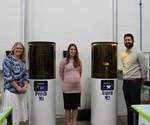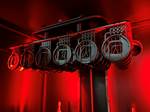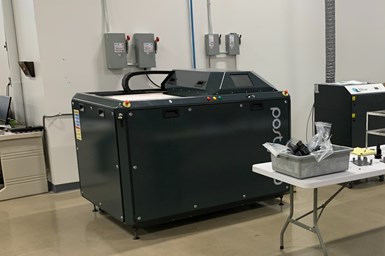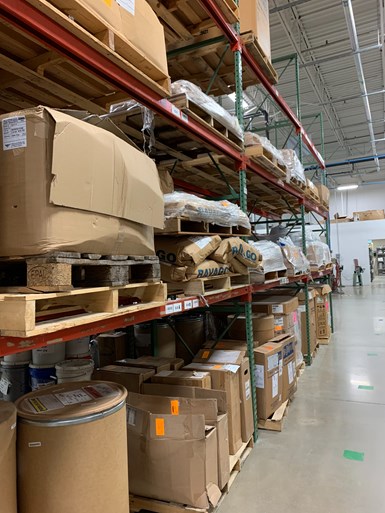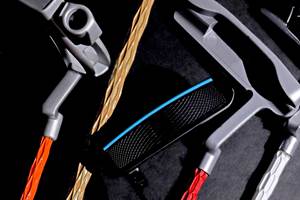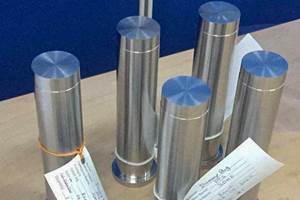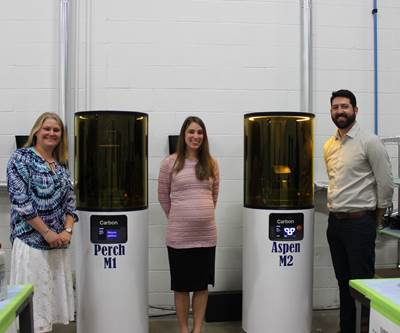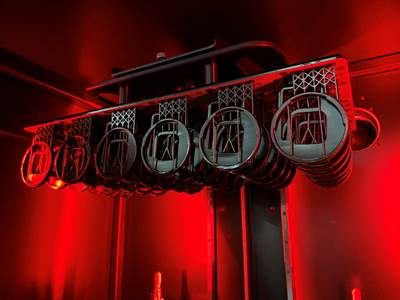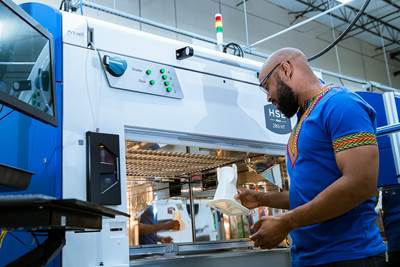In February of 2020, The Technology House in Streetsboro, Ohio, took delivery of its first Multi Jet Fusion 3D printer from HP. Already a committed user of the Carbon digital light processing (DLP) platform, the company saw this new capacity as a way to serve customers needing different materials and larger part sizes. The production work, leadership knew, would come the same way it had on the DLP systems: by collaborating with customers in early stages to prototype and develop parts for this new platform. Not every part prototyped with MJF would ultimately be made this way in full production, but some would, and over time, the production work would come.
But then, March 2020 struck. Suddenly the new HP printer (along with its Carbon predecessors) was needed immediately — for production. The Technology House was one of the many essential businesses tapped to make face shields, ventilator parts, test swabs and more using its 3D printing technology. At the height of the pandemic, the brand-new HP machine was performing 90% production work, says Lauren Good, vice president of finance. The need was so great, the hurdles to conventional manufacturing so high, and the necessary clearances for the medical production so easily forthcoming that 3D printing became the route of choice for production that it might never have won in the “before times.”
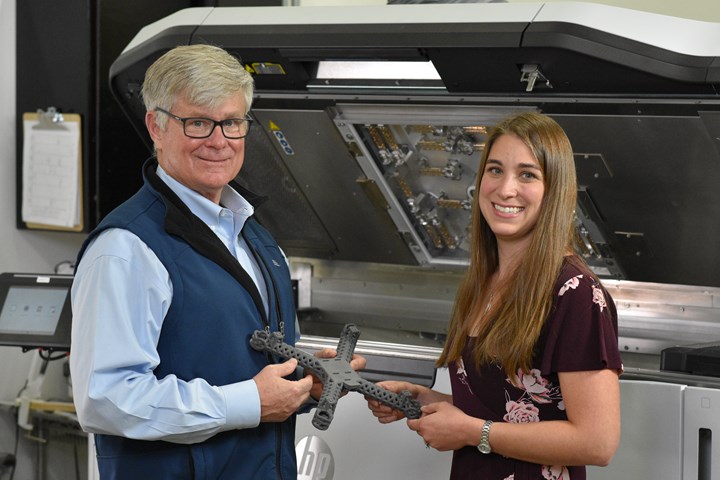
Chip Gear founded The Technology House on the promise of 3D printing for prototyping, but in recent years the company has been pursuing more and more production work with this technology. Gear and his daughter Lauren Good, vice president of finance, are pictured in front of one of the company’s two Multi Jet Fusion (MJF) printers from HP added in 2020 to support this endeavor. Photo Credit: Paul Moskowitz, Akron Video Makers
In 2021, that balance shifted yet again. The Technology House saw production work on its now two HP machines drop back down, to the point that the company is mostly creating prototypes on this platform. Its six Carbon M2s, likewise, are performing about 60% prototyping work to 40% production runs. It might seem that the technology has lost the velocity it gained in 2020, but that isn’t the case, Good says.
“Companies saw the promise from 3D printing in the pandemic,” she explains. Although conventional means of production may have resumed for now, additive manufacturing has made an impression that The Technology House believes will influence how new products come to market and how companies think about their supply chains going forward.
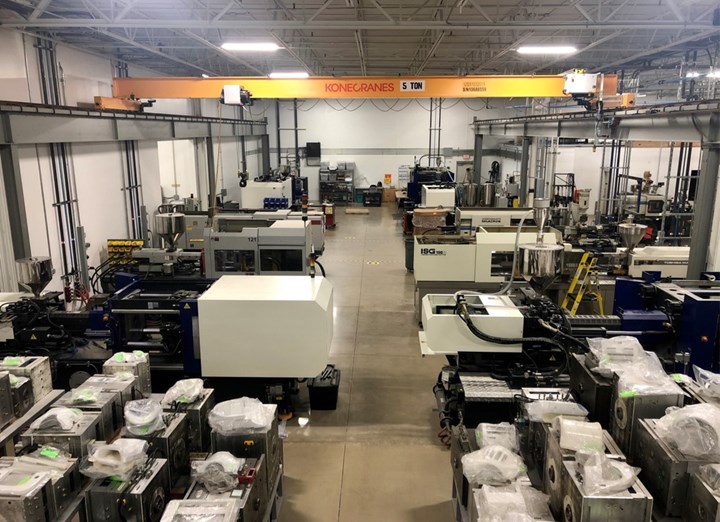
While injection molding (seen here) along with machining and cast urethane continue to make up the majority of The Technology House’s work, 3D printing accounts for about 25% today — a figure the company expects to grow. Photo Credit: The Technology House
3D Printing Before and During a Pandemic
Founded by Chip Gear in 1996 with a single stereolithography 3D printer for prototyping, The Technology House today is a family affair. Gear is still involved in strategic planning, while his three daughters (Lauren Good, Tracy Brent and Nicki Gear) have all found their own niches within the business. The company still performs prototyping and product development services, but now is also engaged in machining, injection molding, urethane casting, painting, assembly and more, in addition to its 3D printing work. When a customer approaches the company with the need for a plastic part, The Technology House has many possible routes to production.
The company has been moving steadily toward this vision for years now. As one of the early adopters of Carbon’s DLP platform, The Technology House has been producing end-use plastic parts on a small fleet of these printers since 2015. Early successful use cases included a nozzle for cleaning Vitamix blenders that combined six previously injection molded parts into one consolidated print, and other case studies in the industrial parts and food industries.
The Technology House operates a fleet of six M2 DLP printers from Carbon. Since this photo was taken the company has added a Carbon L1 3D printer with a larger build volume as well.
But demand from customers prompted the company to pursue ISO certification and validation to 3D print medical devices, and later aerospace parts as well. While achieving certification is difficult enough in the first place, maintaining certification with additive manufacturing (AM) machines holds additional challenges says Tracy Brent, who is president of The Technology House’s sister company Sea Air Space. Because AM is such a digital production process, each new software update to the machines has the potential to overturn the certification. “That doesn’t happen with injection molding, or CNC machining,” she explains, so AM users have to be careful about implementing updates that could alter the machine’s operation.
Still, the effort is worth it. “The certifications build a moat around us,” say Nicki Gear, HR and payroll manager, citing new work that has come as the result of this distinction like components for an MRI machine in progress during my visit.
Today all of the company’s production additive manufacturing equipment is certified for both medical and aerospace applications, a fact that has served the company well in the face of needs created or compounded by covid. “Many medical companies jumped into additive manufacturing because of the pandemic, and the availability of FDA emergency use authorization,” Brent says. Now, some of those companies are continuing to use 3D printing not as an emergency alternative, but as a first-choice manufacturing option.
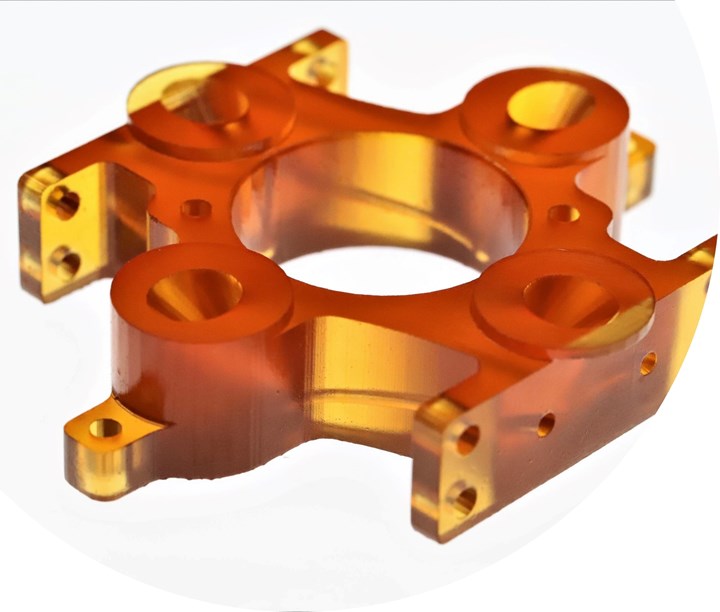
This component made for NASA’s Seeker robot is indicative of the types of parts that The Technology House produces on its Carbon 3D printers. Printed from Carbon’s CE 221 cyanate ester material, this part must withstand high and low temperatures as well as cold-gas propulsion for thrust when flying. Two are used on each Seeker. Photo Credit: The Technology House
How Production Looks Different
Some things about The Technology House are the same as when we last covered the company in 2018. 3D printing is seen and used as a production technology, but it does not replace the company’s other processes. Rather, DLP and now MJF complement the injection molding work, which is mostly low-volume, large parts that would not be a good fit for AM anyway. 3D printing is not the goal, but one potential option. “If the size is right and the material properties are right, we’ll consider for 3D printing,” Good says.
But coming out of a pandemic, things do look somewhat different. Here are some of the ways The Technology House has changed in the past two years:
- Business from new customers has continued. The company today is more likely to print parts not because they were developed and designed for AM, but because they were meant to be injection molded on a tool that is overseas and inaccessible. “These are not necessarily ideal additive parts, but we can print them,” Chip Gear says. The work has brought The Technology House into contact with customers it might never have reached otherwise, and the company sees this as a foot in the door that could help make the case for greater additive manufacturing adoption down the road.
- The company’s design skill has improved, or perhaps its engineers are more adept at asking the right questions, Brent says. Designers today are better able to finesse what is critical and what is not in a customer part, and design for the material and intended additive process. This skill has proven necessary as The Technology House works to serve bridge production needs as described above, where the injection molded design may offer flexibility to allow for 3D printing as an alternative production method.
The Technology House offers value-added services like painting and assembly; the addition of this PostPro3D unit from Additive Manufacturing Technologies supports automated finishing capacity for MJF printed parts.
- Postprocessing has expanded. The Technology House offers a number of finishing services such as painting and assembly that could be applied to either its 3D printed or conventionally manufactured components. But now the expanded 3D printing capability has one more automated option, in the form of a PostPro3D unit from Additive Manufacturing Technologies. The system applies vapor finishing to parts produced on the MJF platform, one more way to add value to these parts.
- Materials have opened new challenges and opportunities. A urethane shortage in 2021 put The Technology House in an awkward yet advantageous position. Many customers had come to rely on the company for cast urethane parts, but when the material was in short supply, The Technology House had another option: PA12 powder compatible with its Multi Jet Fusion 3D printers. MJF combined with vapor smoothing for finishing not only helped The Technology House deliver parts on time but also allowed the company to ramp up production by virtue of the speed of the process. What previously took a week to cast now takes one day to print.
While 3D printing may now be more focused on prototyping again, The Technology House is preparing for production to ramp back up to pandemic levels — and beyond. Since my 2021 visit, the company has added another Carbon machine, an L1 model which will allow it to build larger parts, and has also ordered another printer to support nano-scale electronics work. AM still represents just about 25% of its production (compared to injection molding, machining and cast urethane), but the supply chain weaknesses exposed by the pandemic have helped to elevate this technology’s profile in ways that will carry forward.
“The new customers we gained in 2020 are growing with us,” Good says. “Now we are developing for future production that will happen on this platform.”
Related Content
3D Printed Golf Putter Shafts: AM Tailors Weight Distribution for an Optimized Putting Stroke
Snarr3D offers high-performance golf putters with aesthetic features made possible through 3D printing. In manipulating the weight distribution of the golf putter shaft, Snarr3D aims to enhance accuracy and performance to give golfers the equipment suited to their individual game.
Read MoreThis Year I Have Seen a Lot of AM for the Military — What Is Going On?
Audience members have similar questions. What is the Department of Defense’s interest in making hardware via 3D printing over conventional methods? Here are three manufacturing concerns that are particular to the military.
Read MoreConocoPhillips Sees Oil and Gas Supply Chain Opportunity With Additive Manufacturing
Production of parts when needed and where needed can respond to the oil and gas sector’s multibillion-dollar challenge of holding parts in inventory. The supply chain benefit will justify additive even before the design freedoms are explored.
Read MoreWhy AM Leads to Internal Production for Collins Aerospace (Includes Video)
A new Charlotte-area center will provide additive manufacturing expertise and production capacity for Collins business units based across the country, allowing the company to guard proprietary design and process details that are often part of AM.
Read MoreRead Next
The Technology House Steps into 3D Printing for Production
The Technology House was founded on stereolithography for prototyping, but each step forward has been a move toward production. The company is now 3D printing end-use parts, enabled by Carbon’s SpeedCell line and durable materials.
Read MoreAfter Years in China, 3D Printing Lets Vacuum Accessory Maker Develop U.S. Production
The costs of injection molding had Dustless Technologies making tooling and many parts offshore. Additive manufacturing promises an alternative, as in the case of the company's newest product, which is entirely U.S.-made.
Read MoreHow 3D Printing Answers Supply Chain Disruptions
Essentium CEO: Production-speed additive manufacturing is “a time machine and an insurance policy.” It addresses lead time demands while providing buffer against volatility. Look for 3D printing to support injection molding in this way.
Read More

.jpg;width=70;height=70;mode=crop)
